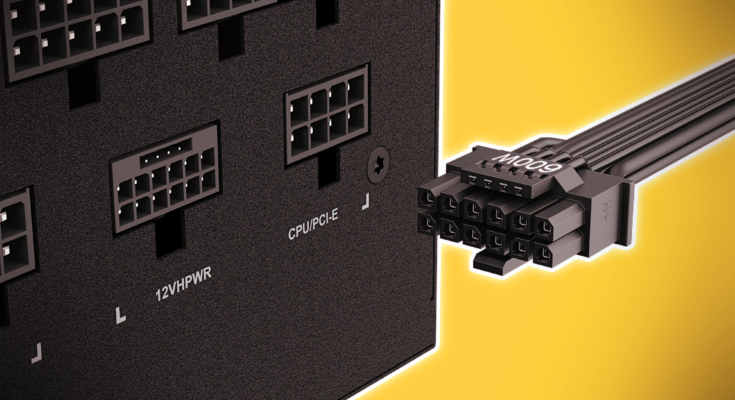Gigabyte confirms that next-gen GPUs will require a new 16-pin power cable or an adapter to comply with PCIe Gen5 specs
We have been covering PCIe Gen5 power connectors for a while now. The first information emerged back in October last year when rumors on GeForce RTX 3090 Ti possible specs have been leaked. Nearly 4 months later, we know a lot more about both the new NVIDIA card as well as the connector itself.
The PCIe Gen5 power cable also known as 12VHPWR or 16-pin power cable is a new standard that will replace existing 8-pin 150W power cables with a single 600W power cable. In order to comply with the 600W specs, the cable needs to have 12 wires for the current and 4 data paths for the signal. The data connectors ensure that the connection has been established and the card actually requires more than 450W of power. In case those data signals are not present, the power supply will feed up to 450W of power.

According to Gigabyte, next-gen PCIe Gen5 graphics cards will be powered either through a single 16-pin power cable or three 8-pin to one 16-pin cable adapters:
The UD1000GM PCIE 5.0 power supply supports the PCIe Gen 5.0 graphics cards and it is capable to deliver the increasing power that the high-end graphics card demand. Traditional power supplies need a three 8-pin to 16-pin adapters to support the latest PCIe Gen 5.0 graphics cards. The new UD1000GM PCIE 5.0 power supply needs only a single 16-pin cable to directly supply power to the PCIe Gen 5.0 graphics cards. Moreover, the PCIe Gen 5.0 16-pin cable provides up to 600 watts of power to the graphics card, but it also simplifies the number of cables, significantly reducing the cable clutter, making the graphics card installation easier and it helps with the airflow in the chassis. In addition, the UD1000GM PCIE 5.0 also provides four PCIe 8-pins for the graphics cards, so it can meet the needs of current or next-generation high-end graphics cards at the same time.
— Gigabyte PR
This is actually the first-ever mention of a triple 8-pin to 16-pin adapter. It is unclear whether Gigabyte refers to the 12+0pin cable or the actual 16-pin cable. The latter must have the data signals connected to comply with 600W specs, otherwise 450W power will be supplied.
Official PCI-SIG PCIe Gen5 power specs are not yet available, hence it is unclear how much different is the PCIe Gen5 “12+0-pin” cable from NVIDIA 12-pin. What we do know is that they are compatible with each other, but NVIDIA never confirmed how much power can go through this cable.
NVIDIA RTX 30 Founders Edition models equipped with a 12-pin connector make use of a 2×8-pin to 1x-12-pin adapter, theoretically only feeding up to 300W of power. Whereas, the ASUS Thor 12-pin connector and cable (not adapter) are officially up to 450W. Due to this distinction, one must assume that they are not ‘exactly’ the same.
Things should become clear once GeForce RTX 3090 Ti and PCIe Gen5 power supplies launch. Those are expected in the coming weeks.
| Maximum Theoretical Power Consumption of a Graphics Card | |||||||
|---|---|---|---|---|---|---|---|
| VideoCardz | PCIe Slot | 6-pin | 8-pin | NVIDIA 12-pin | PCIe Gen5 12+0-pin | PCIe Gen5 16-pin (12+4)-pin | Total Power |
| Example of use | Radeon RX 6400 | GTX 1650 SUPER | Radeon RX 6600XT | GeForce RTX 30 FE | ASUS Thor PSU | RTX 3090 Ti | – |
| Entry-level | 75W | – | – | – | – | – | |
| 75W | 1x 75W | – | – | – | – | ||
| Mid-range | 75W | – | 1x 150W | – | – | – | |
| 75W | 2x 75W | – | – | – | – | ||
| High-end | 75W | 1x 75W | 1x 150W | – | – | – | |
| 75W | – | 2x 150W | 1x 300W* | – | – | ||
| Enthusiast | 75W | 1x 75W | 2x 150W | – | – | – | |
| 75W | – | 3x 150W | – | 1x 450W | – | ||
| Next-Gen | 75W | – | – | – | – | 1x 600W | |
| * No official data | |||||||
Source: Gigabyte



